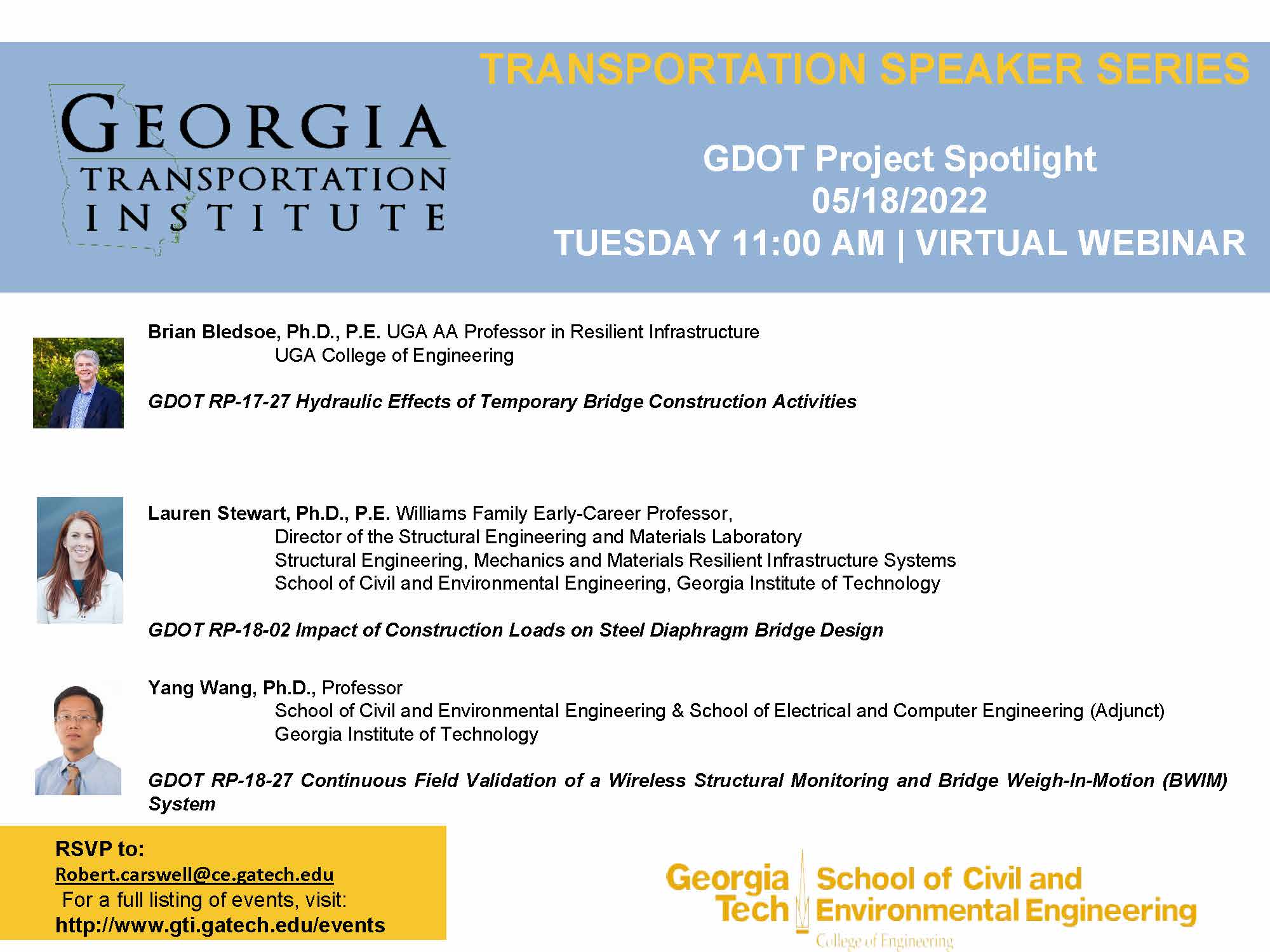GDOT/GTI - Project Spotlight May 2022
Wednesday May 18th, the Georgia Transportation Institute will hosted a 1-hour webinar that spotlighted three recently completed GDOT Research projects. Each project had maximum of a 15-minute presentation, with a short time afterward for questions.
You can join the event by using the Microsoft Teams link below:

Presenter: Brian Bledsoe, Ph.D., P.E., UGA AA Professor in Resilient Infrastructure | UGA College of Engineering
Dr. Bledsoe has over 25 years of experience as an engineer, hydrologist, and environmental scientist in the private and public sectors. Before entering the professorate, he worked in the private sector as a consulting engineer and surveyor, and for the State of North Carolina as a watershed restoration specialist and state nonpoint source program coordinator. Brian’s research is focused on the interface of hydrology, ecology, and urban water sustainability with an emphasis on green infrastructure including streams, floodplains, and stormwater systems. He received an NSF CAREER Award in 2006, and served as a Fulbright Scholar in Chile in 2008.
Title: GDOT RP-17-27 Hydraulic Effects of Temporary Bridge Construction Activities
Abstract:
Bridge construction often requires placement of temporary features such as rock jetties and cofferdams in stream and river channels during the construction process. Environmental permitting agencies seek documentation, and in some cases quantification, of the potential effects of these temporary features on instream velocities and channel bank and bed scour; however, there is no existing guidance or standard method for evaluating the potential effects of these temporary construction features on hydraulics, bank stability, and biological habitats. This research improves the Georgia Department of Transportation’s ability to effectively respond to environmental permitting agency concerns about the potential geomorphic and hydraulic effects of temporary instream jetties associated with bridge construction practices. This report describes the development and application of new modeling and risk assessment tools for predicting average changes in velocity and shear stress in the contracted reach affected by a jetty using readily available information. The results can be used to determine the potential hydraulic and geomorphic effects of jetties prior to structure emplacement, and provides information about the spatial distributions of velocity and shear stress changes near jetties in areas of potential concern. This report also documents the development of a risk assessment that synthesizes 1-D and 2-D hydraulic modeling results and predictive regressions for shear stress and velocity into one comprehensive spreadsheet-based tool for predicting the potential hydraulic and geomorphic effects of jetties when more complex modeling is infeasible. This research can be applied to a large array of structures, including both temporary and semi-permanent in-stream unsubmerged structures, and advances the current set of tools available for preliminary structural design and environmental management decisions.
Presenter: Lauren Stewart, Ph.D., P.E., Williams Family Early-Career Professor,
Director of the Structural Engineering and Materials Laboratory
Structural Engineering, Mechanics and Materials Resilient Infrastructure Systems
School of Civil and Environmental Engineering, Georgia Institute of Technology
Dr. Lauren Stewart joined the Georgia Institute of Technology, Civil & Environmental Engineering faculty as an assistant professor in August 2013. She was promoted to Associate Professor, with tenure in 2019. She received her B.S. in Structural Engineering from the University of California, San Diego in 2004 and her Ph.D. in Structural Engineering also from the University of California, San Diego in 2010. She is a National Defense Science and Engineering Graduate Fellow, an US Air Force Summer Faculty Fellow, and a 2017 Rising Star in Structural Engineering. Prior to coming to Georgia Tech, Dr. Stewart was a Post Doctoral Scholar at the University of California, San Diego from 2010 to 2013. From 2006 to 2013, she worked a Senior Blast Engineer at Karagozian & Case Structural Engineers in California where she holds a PE license. Dr. Stewart’s research is focused on experimental methods for characterized the response of structures to natural and manmade hazards. She has been involved with many blast, shock, impact and seismic experimental and computational programs. These including blast testing of steel structural columns, blast testing of steel stud wall systems, material testing for ultra high performance concrete for impulsive loads and seismic testing for Los Alamos National Laboratories. She has also conducted advanced finite element analysis for the World Trade Center 7 Collapse, AFRL Munitions Directorate small munitions program and programs supported by the Technical Support Working Group. Her design experience includes blast analysis for the Veterans Affairs and consulting projects for various companies.
Title: GDOT RP-18-02 Impact of Construction Loads on Steel Diaphragm Bridge Design
Abstract:
The objectives of this research are: (1) To understand the loads on steel diaphragm bridges during the construction process through visual observation of bridge construction. (2) To measure the effect of construction loads on steel diaphragm bridges during construction via sensors. (3) To quantify the construction loads on the structure using the observations and measured data combined with computational and analytical models. (4) To draft recommended practices (e.g., construction loads) for Georgia Department of Transportation (GDOT) steel diaphragm design. (5) To recommend a standardized GDOT steel diaphragm designs based on the appropriate loading conditions, span lengths and beam types.
Presenter: Yang Wang, Ph.D., Professor School of Civil and Environmental Engineering & School of Electrical and Computer Engineering (Adjunct)| Georgia Institute of Technology
Dr. Yang Wang is a Professor in Civil and Environmental Engineering at the Georgia Institute of Technology, where he also holds an adjunct position in Electrical and Computer Engineering. His research interests include structural health monitoring, wireless and mobile sensors, structural system identification, model updating, and decentralized structural control. Dr. Wang received an NSF Early Faculty Career Development (CAREER) Award in 2012 and a Young Investigator Award from the Air Force Office of Scientific Research (AFOSR) in 2013. In 2017, he received the Achenbach Medal from the international research community in structural health monitoring. Dr. Wang currently serves as an Associate Editor for Structural Health Monitoring – an International Journal (SHMIJ) and the ASCE Journal of Bridge Engineering.
Title: GDOT RP-18-27 Continuous Field Validation of a Wireless Structural Monitoring and Bridge Weigh-In-Motion (BWIM) System
Abstract:
Through this project, the research team has developed and installed a wireless structural sensing system to perform bridge weigh-in-motion. Tens of wireless sensing nodes were installed at an in-service interstate highway bridge that carries the two southbound lanes of I-85 over Georgia State Route 109, outside of the city of LaGrange. The wireless nodes can collect acceleration, strain, and temperature data, which then are used to back-derive the weight of crossing trucks. Controlled testing was performed on the bridge using a loaded dump truck with known axle weights. The data collected from the testing are used to validate the system’s effectiveness. Following the controlled testing, the system was tested in the long-term operational mode.
Theme by Danetsoft and Danang Probo Sayekti inspired by Maksimer


































